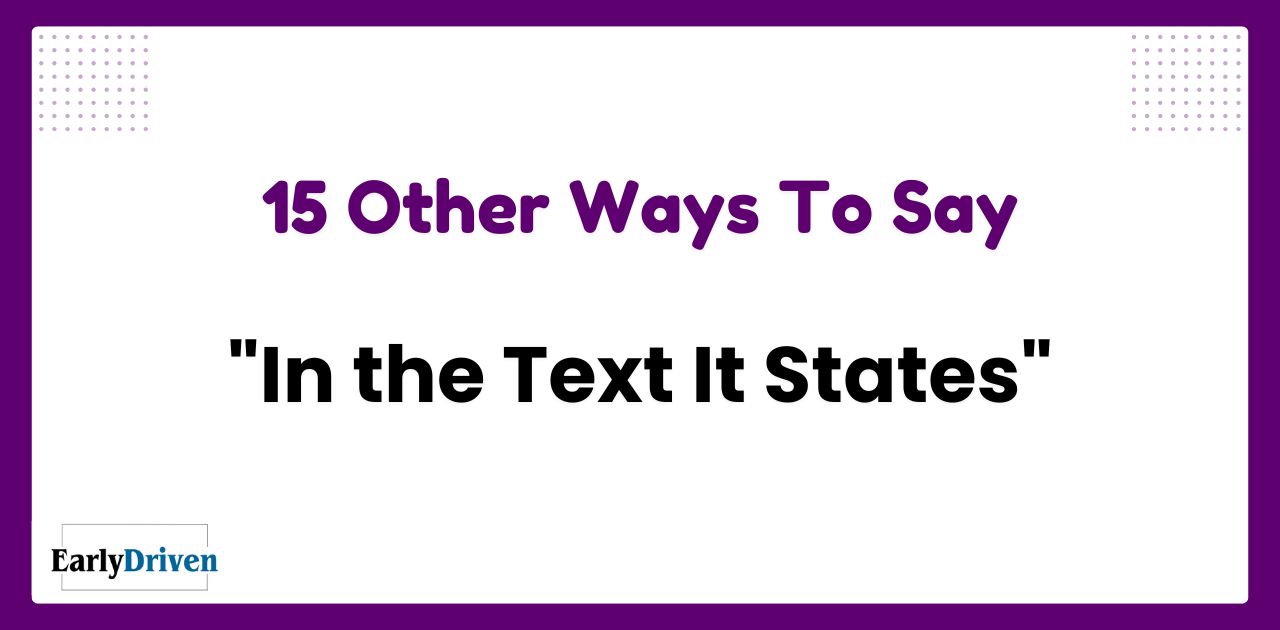In academic writing and analytical writing, the ability to reference source material effectively is crucial for building credibility and supporting arguments. While “in the text it states” is a common phrase, having varied alternatives enhances writing quality and demonstrates sophisticated scholarly communication.
Understanding Source Attribution in Academic Context
Source citation techniques and proper author attribution methods form the foundation of academic integrity. When discussing source material, using diverse referencing phrases not only improves readability but also shows mastery of scholarly communication tools.
Other Ways to Say “In the Text It States”
- The Author Notes
- The Study Reveals
- The Article Points Out
- As Mentioned in the Document
- According to the Text
- The Research Indicates
- In the Given Text
- As Stated in the Source
- As Cited in the Work
- Per the text
- The Writer Argues
- The Text Elucidates
- As Highlighted in the Literature
- The text specifies that
- The text points out that
1. The Author Notes
This phrase effectively attributes statements directly to the writer while maintaining academic formality. It’s particularly useful when discussing an author’s specific observations or conclusions.
Professional Example: “The Author Notes that sustainable urban development requires three key elements: environmental consciousness, social equity, and economic viability. In their analysis of metropolitan growth patterns, they demonstrate how these elements interact through a comprehensive case study of Stockholm’s urban planning initiatives from 2010-2020.”
2. The Study Reveals
This expression is ideal for presenting research findings, especially when discussing empirical data or experimental results. It carries authority and suggests thorough investigation.
Professional Example: “The Study Reveals that implementing mindfulness practices in corporate settings led to a 32% reduction in reported stress levels among employees. The longitudinal analysis, conducted over 18 months across multiple Fortune 500 companies, demonstrates significant improvements in both productivity and job satisfaction.”
3. The Article Points Out
This phrase effectively draws attention to specific observations or arguments within the text. It’s particularly useful when highlighting key findings or crucial details.
Professional Example: “The Article Points Out that traditional marketing strategies are becoming less effective with Generation Z consumers. Through comprehensive market analysis, it demonstrates how digital authenticity and social responsibility have become primary drivers of purchasing decisions among this demographic.”
4. As Mentioned in the Document
This phrase works well when referencing specific details or statements from formal documentation, particularly in technical or business contexts.
Professional Example: “As Mentioned in the Document, the implementation of artificial intelligence in healthcare diagnostics requires strict adherence to privacy protocols and ethical guidelines. The framework outlines specific steps for data protection, including encrypted storage systems and anonymous patient profiling.”
5. According to the Text
A versatile phrase that maintains professionalism while clearly attributing information to the source material. It’s suitable for various academic and professional contexts.
Professional Example: “According to the Text, renewable energy investments have shown a compound annual growth rate of 15.7% over the past decade. This growth trajectory suggests a fundamental shift in global energy infrastructure development priorities.”
6. The Research Indicates
This phrase is particularly effective when presenting data-driven conclusions or evidence-based findings. It emphasizes the scientific nature of the information.
Professional Example: “The Research Indicates that remote work arrangements have led to a 23% increase in employee satisfaction while maintaining productivity levels. The analysis, based on data from 500 companies across various sectors, challenges traditional office-centric work models.”
Read Also: 15 Other Ways to Say “I Hope Everything Is Going Well With You”
7. In the Given Text
Useful for direct references to assigned or specific materials, especially in academic or analytical contexts.
Professional Example: “In the Given Text, the economic impact of climate change is analyzed through multiple scenarios, with particular emphasis on coastal regions. The models project potential GDP losses ranging from 2% to 5% annually by 2050 without intervention.”
8. As Stated in the Source
This phrase provides clear attribution while maintaining a formal tone, ideal for professional and academic writing.
Professional Example: “As Stated in the Source, artificial intelligence applications in medical diagnostics have achieved accuracy rates exceeding 95% in identifying early-stage cancer markers. This breakthrough represents a significant advancement in preventive healthcare.”
9. As Cited in the Work
Perfect for formal academic references, particularly when discussing scholarly research or peer-reviewed materials.
Professional Example: “As Cited in the Work, neuroplasticity continues throughout adulthood, contradicting earlier beliefs about fixed cognitive development. This finding has profound implications for adult education and rehabilitation programs.”
10. Per the Text
A concise yet professional alternative, suitable for frequent citations within the same document.
Professional Example: “Per the Text, sustainable agriculture practices have demonstrated a 40% reduction in water usage while maintaining crop yields. These methods integrate advanced irrigation systems with traditional farming knowledge.”
11. The Writer Argues
This phrase is particularly effective when presenting theoretical positions or controversial viewpoints while maintaining academic objectivity.
Professional Example: “The Writer Argues that current educational frameworks require fundamental restructuring to address 21st-century skills gaps. Through comprehensive analysis of employment trends and educational outcomes, they present evidence that traditional curriculum models are increasingly misaligned with workplace demands.”
12. The Text Elucidates
This sophisticated alternative is ideal for introducing detailed explanations or complex concepts. It suggests thorough illumination of a topic.
Professional Example: “The Text Elucidates the intricate relationship between microeconomic behavior and macroeconomic outcomes in developing economies. Through detailed case studies of Southeast Asian markets, it demonstrates how individual consumer choices collectively influence national economic trajectories.”
13. As Highlighted in the Literature
Perfect for literature reviews and discussions of established academic discourse, this phrase connects individual points to broader scholarly conversations.
Professional Example: “As Highlighted in the Literature, the impact of social media on adolescent mental health shows complex patterns of both positive and negative effects. Recent meta-analyses suggest that the quality of online interactions, rather than quantity, determines psychological outcomes.”
14. The Text Specifies That
This phrase is particularly useful when referring to precise requirements, guidelines, or technical specifications.
Professional Example: “The Text Specifies That quantum computing applications in cryptography must maintain backward compatibility with classical systems while implementing post-quantum security measures. The framework outlines specific protocols for this hybrid approach.”
15. The Text Points Out That
Effective for emphasizing significant observations or conclusions while maintaining professional distance.
Professional Example: “The Text Points Out That biodiversity loss in tropical rainforests accelerates exponentially once deforestation exceeds 20% of the original forest cover. This finding has crucial implications for conservation policy and sustainable resource management.”
When to Use Different “In the Text It States” Alternatives
For Direct Author Attribution:
- Use when emphasizing the author’s perspective
- Appropriate for analytical discussions
- Maintains clear source attribution
For Academic or Scholarly Contexts:
- Select formal alternatives for academic papers
- Ensure consistency with citation styles
- Maintain professional tone throughout
For Discussing Research Findings:
- Choose phrases that emphasize empirical evidence
- Use when presenting data-driven conclusions
- Maintain scientific objectivity
For Highlighting Specific Points or Arguments:
- Select phrases that draw attention to key ideas
- Use when emphasizing crucial findings
- Maintain clarity in complex discussions
For Emphasizing Source Material or Documentation:
- Choose phrases that clearly reference specific documents
- Use when precision is crucial
- Maintain documentary evidence trail
When Referring to a Collective Body of Work:
- Select phrases that acknowledge broader research context
- Use when discussing established literature
- Maintain connection to wider academic discourse
FAQ’s
Q: How often should I vary my attribution phrases?
A: Aim to vary phrases every 2-3 citations while maintaining natural flow and appropriate context.
Q: Can these phrases be used in all academic disciplines?
A: Yes, though some phrases may be more common in certain fields. Consider your discipline’s conventions.
Q: How do these phrases work with different citation styles?
A: All these phrases can be adapted to work with any citation style (APA, MLA, Chicago, etc.) while maintaining proper formatting.
Q: What is another way to say “in the text it states”?
A: You can use professional alternatives like “the author notes,” “according to the text,” or “the research indicates.” These variations maintain academic credibility while improving writing flow.
Q: What is a better way to say “in the text”?
A: Professional alternatives include “in the source material,” “within the document,” or “throughout the literature.” Choose based on your specific context and the type of source you’re referencing.
Q: What to say instead of “as stated” in the text?
A: Consider using “as indicated,” “as demonstrated,” or “as presented.” These alternatives convey the same meaning while adding sophistication to your academic writing.
Q: What is a synonym for “in the text it says”?
A: Professional options include “the text elucidates,” “the document specifies,” or “the source material indicates.” These alternatives enhance the scholarly tone of your writing.
Q: What can I use instead of “in the text”?
A: You can use “in the source,” “in the document,” “in the literature,” or “in the research.” Choose based on the type of material you’re referencing and your academic context.
Q: What is a better word for “stated”?
A: Professional alternatives include “noted,” “emphasized,” “highlighted,” “demonstrated,” or “explained.” These words can add precision and clarity to your academic writing.
Q: How do you reference text examples professionally?
A: Use phrases like “as demonstrated in,” “as illustrated by,” or “as evidenced in the text.” These expressions maintain academic formality while clearly introducing examples.
Q: What is a synonym for “stated in the text”?
A: Professional alternatives include “documented in the source,” “presented in the material,” or “outlined in the work.” These variations help maintain academic sophistication while avoiding repetition.
Conclusion
Mastering these alternatives to “in the text it states” enhances academic credibility and demonstrates sophisticated scholarly communication. These variations allow writers to maintain engagement while adhering to academic standards. By incorporating these alternatives thoughtfully, writers can create more polished and professional academic works that effectively communicate their research and analysis.
Remember that the key to effective academic writing lies not just in varying phrases but in using them appropriately within context. This careful attention to writing clarity and accuracy distinguishes excellent academic work and contributes to more effective scholarly discourse.
Elevate you English Learning Skills with our Mastery Blogs!

“Smith, At EarlyDriven, our dedicated team of experienced writers and journalists brings you comprehensive coverage across entertainment, celebrity news, and educational content. With expertise in digital media and a commitment to accuracy, we craft engaging stories that inform, educate, and entertain our global readership.










